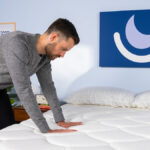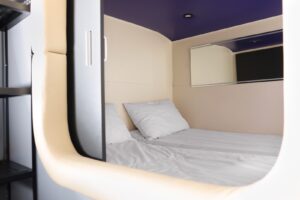To help combat daytime sleepiness, workplaces and universities are installing what are called nap pods. Nap pods are a unique piece of furniture designed to create an optimal sleeping environment in offices, hospitals, and libraries for students, healthcare workers, and employees to rest and catch up on sleep during their busy days.
What Exactly Are Nap Pods?
Nap pods, also called sleep pods, are a piece of furniture that is used for sleeping at work or in other public places. They are different from beds and reclining chairs because they are specifically designed to create a controlled and comfortable environment for sleeping in public.
Some nap pods are freestanding chairs shaped like an egg with a cover for a person’s head, while others are small, soundproofed rooms that have a bed inside. Nap pods are usually located in a quiet space such as an airport lounge, library, or dedicated office that is separated from busy, high-traffic areas.
To use a nap pod, you lay down on the bed and relax. For some models, sitting down will prompt a control panel to launch that allows you to adjust the settings based on your preferences. Once you finish your nap, you’re supposed to use a disinfectant wipe or cloth to clean the nap pod for the next person.
What Features Can a Nap Pod Have?
Nap pods have an ergonomic design to help facilitate a comfortable nap and are available in different shapes and sizes. To make sleeping in public as comfortable as possible, nap pods have an array of sophisticated technical features.
- Spacious: Nap pods come in various sizes and lengths. Certain nap pod models are over seven feet long, providing plenty of room to accommodate users of all sizes.
- Incline: Some nap pods allow users to adjust the incline level so they can lay flat or slightly elevated, depending on their preference.
- Noise Control: Since a loud workplace could interrupt sleep, some nap pod models include built-in speakers with soothing music and white noise to drown out background noise.
- Vibration: Certain types of nap pods include the option to add vibrations or a zero gravity experience to help soothe users into sleep.
- Storage: Storage space may be provided for people to safely stow their belongings nearby while they nap.
- Timers: Some nap pods have programmed timers set to an optimal nap length, such as 20 minutes, to prevent deep sleep. Once the timer ends, the nap pod may wake users with light and soft vibrations.
Best Ways to Take a Nap
To make sure your naps give you the greatest benefit they can, it can help to keep in mind how long your naps last and what time of day you take them. You may also wish to experiment with different types of naps, such as a caffeine nap.
Who Uses Nap Pods?
Workplaces, universities, airports, and hospital settings are gradually adopting nap pods to help employees, students, travelers, and healthcare workers get the rest that they need. About 74% of healthcare workers who used nap pods at work described a positive impact on their physical health, mental health, and stress levels. Several types of people may benefit from using nap pods:
- Healthcare Workers: Since being alert is crucial for healthcare workers to avoid making dangerous mistakes, nap pods could be a helpful option for hospitals. A study found that providing nap pods for doctors and nurses resulted in improved alertness at the end of the shift as well as feeling more safe when driving home after work.
- Shift Workers: Naps can help counteract sleepiness and make people more alert on the job, suggesting that shift workers may benefit from nap pods in their workplace. Shift workers may have a night or morning shift that changes by week which can result in sleep problems and extreme tiredness.
- Students: Sleep deprived high schoolers and college students may benefit from nap pods at their schools and universities. Up to 80% of high schoolers may not be getting enough sleep each night. School or work obligations, busy schedules, and mental health troubles can result in insomnia among students.
Nap Pods in the Workplace
Some prominent workplaces and institutions have incorporated nap pods in order to improve the wellbeing and productivity of their employees. Workplace culture, leadership pressure, and workload can play a role in whether people believe they are allowed to rest and take breaks at work.
Several organizations and healthcare facilities have installed nap pods in dedicated spaces such as relaxation rooms to encourage a culture of wellness and fight the stigma of taking rest at work.
- Hospitals: In the United Kingdom, the National Health Service departments have installed nap pods and provided sleep hygiene education to encourage hospital staff to get adequate sleep before and during their shift.
- Universities: University of California Santa Barbara and University of Colorado Boulder have added nap pods to their campuses for students. Many other colleges have begun to add nap pods and sleeping stations to campus libraries as well.
- Companies: Google, Uber, Nike, Samsung, Ben & Jerry’s, and Proctor and Gamble are just some of the many companies that offer nap pods on-site for employees.
- Government Agencies: The National Aeronautics and Space Administration (NASA) and the Federal Aviation Administration (FAA) have nap pods available for employees to rest.
References
Ask the Sleep Doctor
Have questions about sleep? Submit them here! We use your questions to help us decide topics for articles, videos, and newsletters. We try to answer as many questions as possible. You can also send us an email. Please note, we cannot provide specific medical advice, and always recommend you contact your doctor for any medical matters.

